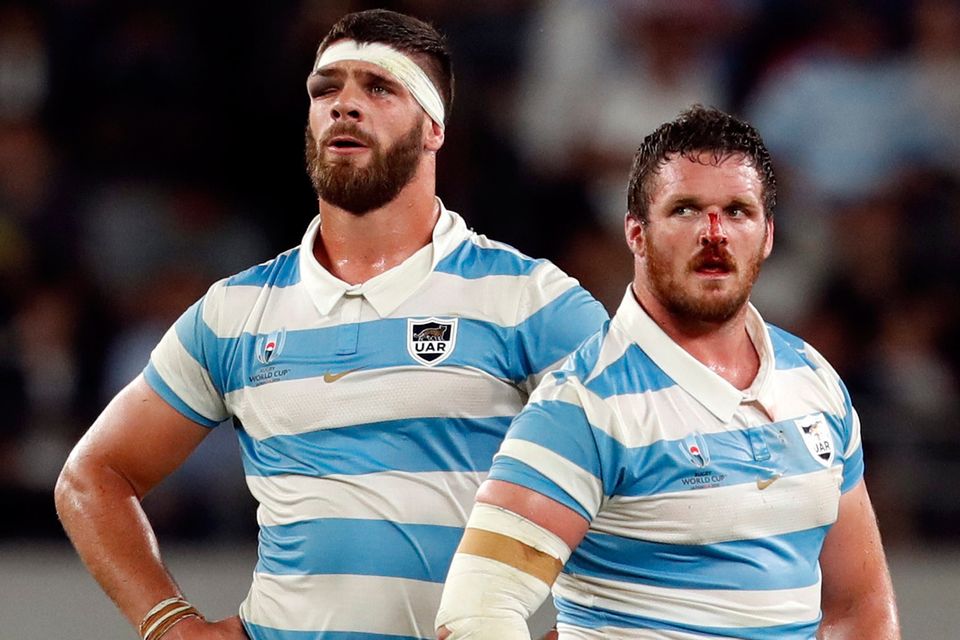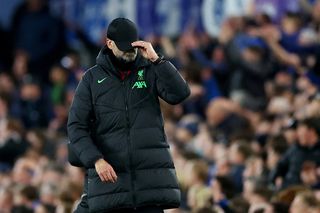Brendan Fanning: 'World Rugby's influence set to dwindle further as rugby world moves towards huge change'
Black and blue: Argentina’s Marcos Kremer, left, Julian Montoya after their bruising game against France. Photo: Reuters
One of the most uncomfortable post-match presentations in rugby history took place on the turf of the Sydney Football Stadium in 1995.
The third Rugby World Cup had wrapped up in South Africa a month earlier, and this Test between Australia and New Zealand drew down the curtain on the Test season in the southern hemisphere. It sounded like it was closing the door on the game itself.
The background had been dominated by a battle to decide should the game remain amateur or go professional - the decision would come in Paris a month later - but listening to the captains and union presidents that day in Sydney was like watching a game of musical chairs where getting a seat was as awkward as being left standing.
If back in 1995 the Aussies and Kiwis were looking at each other waiting for someone to make a move, then last week in Japan Brett Gosper sounded like the music had just stopped. And he hadn't made his move. Like the blazers in Sydney, the World Rugby CEO was very unsure about what the future would hold.
Gosper was commenting on reports that the private equity firm CVC Capital Partners had, in principle, just added the Six Nations to its rugby portfolio at a handy £300m for a 15 per cent stake. In effect, they are buying a seventh share in the competition.
"Someone who is as big an investor in the sport as a private equity firm like CVC will create influence," he said. "That is something that in some areas could concern us. When you have a high-funding commercial owner of the sport that isn't the governing body then certain calls can be made which we might think aren't in the interests of the sport's growth, player welfare or other areas. We would want to make sure things are being done for the right reasons and that our influence wasn't usurped."
If this sounds like a man whose influence has just suffered a humungous usurping then that's about right. It was writ large when three months ago World Rugby had their plans for a Nations Championship shot down. Designed to keep the Tier 1 nations in financial clover and put a global gloss on the season, it crashed to earth on the back of a few missiles - the direct hit being the prospect of relegation from the Six Nations.
WR's model had been thrown into the ring to stop Six Nations running off with CVC who already were all over them like a rash. It left the governing body looking a bit like the ERC all those years ago when their influence on the European club game began to unravel.
So, what's with a crowd like CVC getting on board the rugby train? Would you believe, of the many who have invested in the game since 1995 these lads and lassies have a decent chance of getting plenty of bang for their buck. It helps that the modus operandi of private equity firms is straightforward: multiply your money in five to seven years; scoop it up; leave. Unlike the many owners and sponsors who have signed their cheques with heart emojis tacked on, these folks are all about the cash.
When they arrived in the pit lane of Formula One in 2006 they were hitching themselves to a sport with a track record of spewing bank notes out exhaust pipes and into the kitties of its investors. CVC brought that to record levels, leaving many within the sport pissed off that free-to-air television coverage was decimated, and relatively little was being reinvested in the sport.
More recently, they have turned their focus to rugby, and have taken a slice of the pie at Premiership Rugby - 27 per cent for £200m - and are closing in on 30 per cent of the Pro14 for £120m. Ideally, private equity likes to take a majority stake, but in the absence of that they may settle for tidying up the commercial side of the house.
In the case of the Six Nations that's likely to involve bundling the television package together with Premiership Rugby and the Pro14 and presenting the telephone numbers to a behemoth such as Amazon. Television deals ain't what they used to be, mainly because the youth of today don't spend as much time in front of the box as their parents. They consume sport on their phones as much as on television. When they go to games they whip the phones out for replays and social media updates. So sport has to follow.
That means big fat content packages - obviating the need for consumers to sign up to a handful of different providers - for big fat numbers. So what can possibly go wrong?
Well, if you think that keeping your sport on free-to-air TV was a good idea then its equivalent nowadays hasn't diminished. It remains to be seen how CVC can square this circle. On the one hand you have an investor who only want their return; on the other you have the provider who wants the cash to fund the sport but has to keep the images on as broad and cheap a platform as possible.
If CVC's influence was greater we might be tuning in to Six Nations ties from Hong Kong and New York, in a calendar skewed even further than the one which is already struggling to cope. It might not get to that in the short term but expect everything around the game to be sexed up and dumbed down with a view to generating more coin, and then selling it on. And that bit is important for it is inconceivable that CVC would inject that kind of money and have their hands tied with regard to who they can sell their stake to when it's time to cash in their chips.
That might be a while off. They stayed in Formula One longer than the industry norm, and the prospect of getting outright control of the Six Nations would be attractive. That's what Brett Gosper was alluding to in Japan last week: a landscape where everything is high-rise and shiny but ordinary folks can't get access without paying over the odds.
The recurring theme in this country has always been about the need to cover the costs at the top end of the game in order to feed the grassroots. For sure, CVC will pony up enough to stock warehouses with bibs, balls and cones, but what will the game look like, and who will actually be able to see it?
It's easy to go back only as far as the demise of ERC, the body run solely by the unions of the Six Nations, as the start of the powerplay for control of rugby. It wasn't. The Heineken Cup had been cobbled together in haste to give pro rugby in Europe something to carry it along, and what a fantastic job it did. But in truth the battle had kicked off long before that. Its first public airing was on a pitch in Sydney in 1995.















